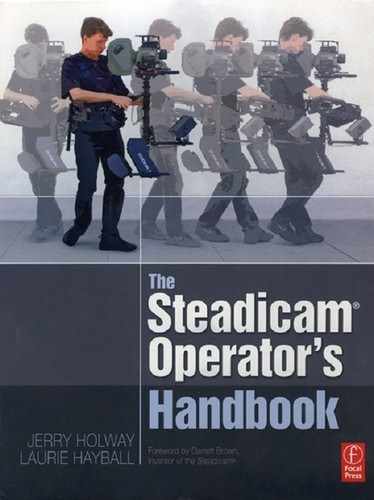Preparing for a shoot
you and your equipment
Before you get there
You need to arrive on the set as prepared as possible. If you have been hired for an entire show, you will probably be given prep days to organize and test your equipment and settle in on the camera truck. However, much Steadicam work is day playing, and you need to gather a lot of information quickly to prepare yourself for the job. If you forget some critical piece of equipment, there may not be time to find it, and they may be forced to find an alternative to the Steadicam shot. This is not okay!
Take the time to find out details about the equipment, location, and script.
Technical stuff
What type of camera will you be using? Will it be exclusively yours, or are you sharing the A-camera?
Will the camera be prepped at a rental house? If so, take your rig and set it up with the camera. This can be really useful in terms of organizing the cables you need and making preliminary marks for balancing. Make sure you can get a picture on your monitor from the cameras video tap. Take the time to set up the rig in high and low mode. Does the rental house have a low mode bracket or do you need to supply one?

Test your follow focus gears and position the motors to work for both high and low mode. Mark everything for ease of setup and speed when changing to low mode.
Will you bring your own assistant or use one from the production? If it is someone you don't know, get a name and phone number. Be sure to speak to the assistant before you go to work. Find out his experience. Ask detailed questions about the camera, cables, working conditions, etc. Does he know how to use your follow focus?
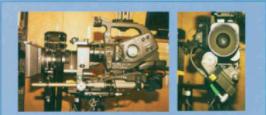
A Hedén motor on the Flyer. With the Flyer, the mattebox rods are typically used to mount the motors. You may have to do something special to keep the rods from rotating.
If you won't have a chance to see the assistant before the day, make sure all your gear is clearly labeled and sensibly arranged in the cases. (This is a good idea anyway.) That way it will be simple for anyone to help you get set up and to find the stuff you need.
If you are bringing your own assistant, great! Make sure he is up to speed on all the information you have gathered. Practice with your assistant to be efficient in changing set-ups, etc.
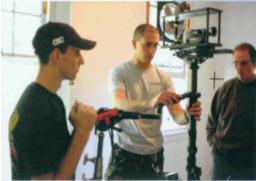
It helps if your assistant can put together your rig and do the initial balancing for you. If your shot is first up, the director or DP may call you off to talk about the shot before you get your rig built. If you are working with someone new, make sure you give yourself enough time to get set up before production may need you.
A question not asked:
Mid 1990s: I'm hired for a job on the west coast. The camera is a Moviecam Compact, which was fairly new at the time. I'd used it many times on the east coast, and felt confident that all was okay. I did not have a proper conversation with the AC about the camera. On the east coast, the camera is rented with a low mode bracket. On the west coast, operators owned their own low mode brackets. I show up on set, the shot is low mode, and it's Saturday night. We scramble, eventually find an operator who will lend us his bracket, and we barely get the shot. Don't assume anything. Talk.
A lot of up-to-the-minute technical information and concerns are discussed on the Steadicam Forum (www.steadicamforum.com). Read the posts and discover what other operators are interested in, what their problems and solutions are. Ask questions on the forum when you have enough lead time.
Physical conditions
When day playing, you are usually called in for a specific reason. Sometimes it is a Steadicam shot that has already been conceived by the director. Other times you are the only solution to a logistical problem: “This rickety old bridge won't support the weight of the crane. Let's get a Steadicam for tomorrow.”
Gather as much information as you can so you can arrive prepared. Ask questions about the project, and specifically the piece you are shooting. Where does it take place? Is it a practical location or a sound stage? Are you on an aircraft carrier or shooting from one dinghy to another?
Is it a day or night shoot? Will weather be a factor? Do you need special shoes? Will you be mounting to a vehicle? Will you need your safety harness? Are you going to be shooting around sand or water? Will there be any special fx or pyrotechnics? You want to protect yourself and your gear!
Take care of your feet
Wear the right shoes, and change your socks and shoes at least once during the day. Really. You take off the vest as much as possible to give your torso and back muscles a break; at least give your feet a break at lunch as well. Many in the crew also will appreciate you changing your shirt midday.
What shoes to wear? At a minimum, get two pairs of the best cross-trainers you can find. Damn the expense; your feet are carrying your career, and two pairs of shoes that you rotate will last more than twice as long as buying one pair, then another when the first wears out. Have yet another pair of shoes for getting to work, while you wait around, and for going home. Some operator's feet are naturally warmer than others or sweat more. Your choice of shoe depends on your feet and the environments you will be working in. I happen to like New Balance shoes because they fit my feet, but you need to find the best shoes for your feet.
Generally you want black shoes, or dull colored ones that do not call attention to themselves. Many operators we know like the Merrill® brand - they make a variety of sporting shoes, from very light weight and airy cross-trainers to really warm and waterproof boots. Some operators also swear by various insoles, air pumps, and foot massage oils. You can never massage your feet enough! Some other not so well-known brands to check out: Shoes for Crews®, Mephisto, and Salomon. Also check out shoes for different conditions, like golf shoes with hard, sharp spikes for ice and soccer shoes with big cleats for mud and wet grass.
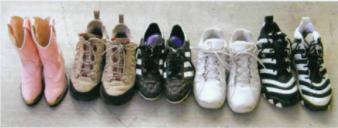
Performance
Get a copy of the script or have production email the scene you will be shooting or the sides for the day. Read them. Know the actors and who plays what part. Is it a comedy or a drama?
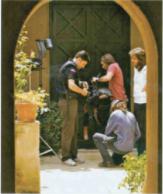
If necessary, make repairs to your gear away from the set.
A Steadicam operator should arrive on the set prepared to help tell the story, not just to look cool flying the camera around for the day.
On the day
When is the first Steadicam shot? If you are first up, then get cracking. No time to lose. Assemble the camera with follow focus and transmitter. Static and dynamic balance the sled. Organize your gear tools, arm posts, low mode accessories and batteries should all be accessible.
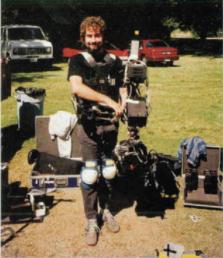
If you are not scheduled until later in the day, but you have your own camera, set everything up and test it right away.
Don't make a spectacle of yourself. Quietly, efficiently set up your rig next to the camera truck, out of people's way. The A-camera may be needed right away, so other people will be working in the same space.
Once you are good to go, you can relax, have breakfast,chat with the extras, etc.
If you are sharing the A-camera, arrange with the first assistant to get you a few minutes with the camera either before call or at lunch if you aren't working until the afternoon. Set up your rig, balance with the camera, mark everything. This way, when it is your turn, you won't be starting from scratch.
If you can only have the camera for a moment, mark the camera's e.g. This will aid you in placing the camera later. You can also make a plan regarding how you are going to attach focus motors, and have everything set out and ready.
Make sure the camera assistants set up your battery chargers, and understand how to operate them. We've had the misfortune of finding batteries set to revitalize or discharge in the middle of a long day of work.
Always immediately test your monitor, focus motors, and wireless transmitter/receiver. The sooner you know you have a problem, the sooner it can be solved.
What's the shot?
If you don't already know from your exhaustive prep the day before, find out what shots you are going to be doing today. If the director or DP isn't available, the assistant director can be helpful with this kind of information.
Will you need anything from other departments to get the shot done with proficiency and ease? Maybe you need something built by the grips.
If there is to be a vehicle mount, get it started. Be specific when talking to the grips about how and where the Steadicam will be mounted. Make sure you have worked out the shot with the director or DP before you have the grips rig something. You won't want to ask them to do it over again. You will need a clear understanding of the shot, specifically lens height, to get the vehicle rigged properly.

Some operators get their gear all organized, built. and ready to go before call.
